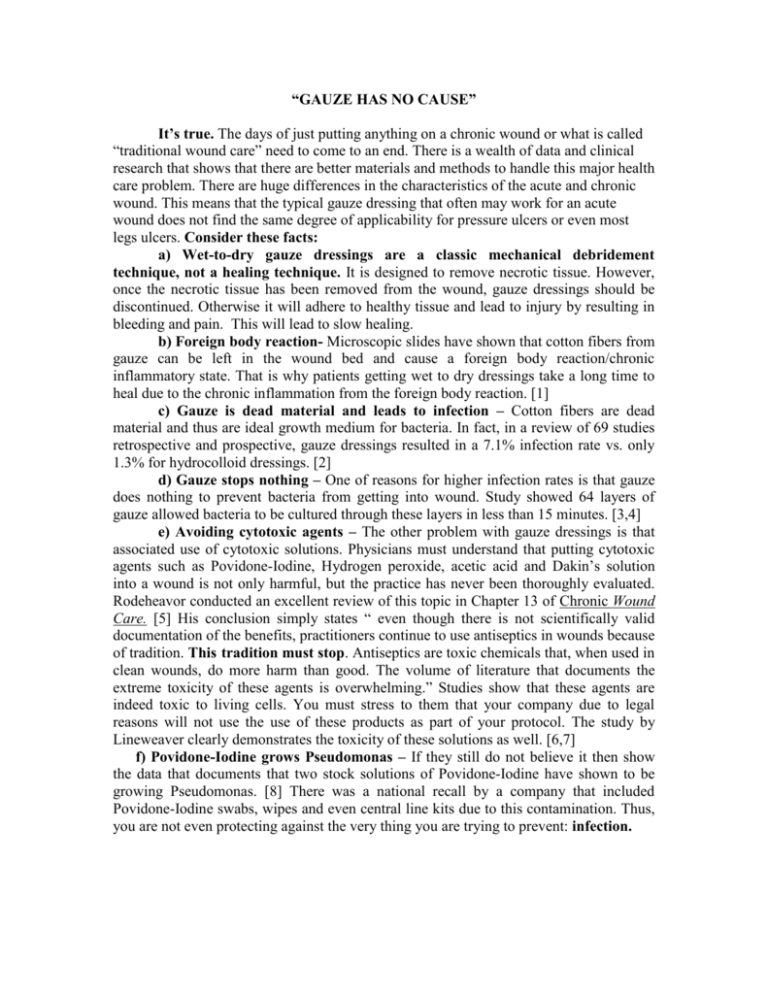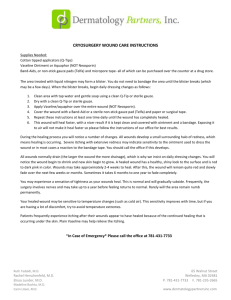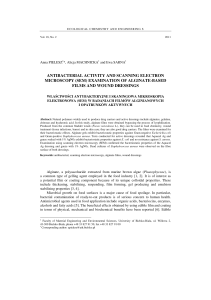Gauze Has No Cause
advertisement

“GAUZE HAS NO CAUSE” It’s true. The days of just putting anything on a chronic wound or what is called “traditional wound care” need to come to an end. There is a wealth of data and clinical research that shows that there are better materials and methods to handle this major health care problem. There are huge differences in the characteristics of the acute and chronic wound. This means that the typical gauze dressing that often may work for an acute wound does not find the same degree of applicability for pressure ulcers or even most legs ulcers. Consider these facts: a) Wet-to-dry gauze dressings are a classic mechanical debridement technique, not a healing technique. It is designed to remove necrotic tissue. However, once the necrotic tissue has been removed from the wound, gauze dressings should be discontinued. Otherwise it will adhere to healthy tissue and lead to injury by resulting in bleeding and pain. This will lead to slow healing. b) Foreign body reaction- Microscopic slides have shown that cotton fibers from gauze can be left in the wound bed and cause a foreign body reaction/chronic inflammatory state. That is why patients getting wet to dry dressings take a long time to heal due to the chronic inflammation from the foreign body reaction. [1] c) Gauze is dead material and leads to infection – Cotton fibers are dead material and thus are ideal growth medium for bacteria. In fact, in a review of 69 studies retrospective and prospective, gauze dressings resulted in a 7.1% infection rate vs. only 1.3% for hydrocolloid dressings. [2] d) Gauze stops nothing – One of reasons for higher infection rates is that gauze does nothing to prevent bacteria from getting into wound. Study showed 64 layers of gauze allowed bacteria to be cultured through these layers in less than 15 minutes. [3,4] e) Avoiding cytotoxic agents – The other problem with gauze dressings is that associated use of cytotoxic solutions. Physicians must understand that putting cytotoxic agents such as Povidone-Iodine, Hydrogen peroxide, acetic acid and Dakin’s solution into a wound is not only harmful, but the practice has never been thoroughly evaluated. Rodeheavor conducted an excellent review of this topic in Chapter 13 of Chronic Wound Care. [5] His conclusion simply states “ even though there is not scientifically valid documentation of the benefits, practitioners continue to use antiseptics in wounds because of tradition. This tradition must stop. Antiseptics are toxic chemicals that, when used in clean wounds, do more harm than good. The volume of literature that documents the extreme toxicity of these agents is overwhelming.” Studies show that these agents are indeed toxic to living cells. You must stress to them that your company due to legal reasons will not use the use of these products as part of your protocol. The study by Lineweaver clearly demonstrates the toxicity of these solutions as well. [6,7] f) Povidone-Iodine grows Pseudomonas – If they still do not believe it then show the data that documents that two stock solutions of Povidone-Iodine have shown to be growing Pseudomonas. [8] There was a national recall by a company that included Povidone-Iodine swabs, wipes and even central line kits due to this contamination. Thus, you are not even protecting against the very thing you are trying to prevent: infection. It is time to update our approach towards wounds among physicians. We have fallen way behind in this field. The old thinking and opinion that chronic wounds are a nursing problem is just that: OLD THINKING. We are not helping the situation by using cytotoxic agents and traditional gauze dressings. Gauze has no cause. Coming to this realization is not easy, but a necessity. Learn why moist wound healing works and why it will help heal your patients better, faster and more cost effectively. S. Kwon Lee, MD FACS Bibliography 1) Hughes M. Basic Wound Healing Science Now and in the Future. 4th Annual Oxford European Wound Healing Summer School. Oxford, UK. June 1999. 2) Hutchison JJ, Occlusive dressings: A microbiologic and clinical review. Am J Infect Contr. 1990; 18:257-268. 3) Lawrence JC. Dressings and wound infection. Am J Surg. 1994(suppl 1A): 21S-24S. 4) Mertz PM, Marshall DA, Eaglstein WH. Occlusive wound dressings to prevent bacterial invasion and wound infection. J Am Acad Dermatol. 1985; 12:662-668. 5) Rodeheavor G, Wound cleansing, wound irrigation, and wound disinfection. In: Krasner D, Kane D. Eds. Chronic Wound Care: A Clinical Source Book for Healthcare Professionals, 2nd Ed. Wayne PA. Health Management Publications, 1997, 97-108. 6) Lineweaver, Cellular and bacterial toxicities of topical antimicrobials. Plast Reconstr Surg 1985a; 75:394-396. 7) Lineweaver W. Topical antimicrobial toxicity. Arch Surg 1985b; 120:267-270 8) Burks RI, Povidone-iodine solution in wound treatment. Phys Ther. 1998; 78:212-218.





